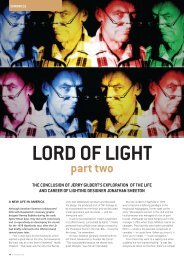Group X - Starfarer's Hawkwind Page
Group X - Starfarer's Hawkwind Page
Group X - Starfarer's Hawkwind Page
You also want an ePaper? Increase the reach of your titles
YUMPU automatically turns print PDFs into web optimized ePapers that Google loves.
Living in flats at Addison Crescent (some 500m south-west of Notting Hill Gate), between 1965-67 Fulcher teamed up with two<br />
college friends to organise private events & ‗happenings‘ before moving on to operate a light show for Quintessence, Gun & other<br />
bands at gigs & multi-media events at the Electric Cinema (where he met projectionist Jon Smeeton, a.k.a. Liquid Len), Roundhouse,<br />
Middle Earth & the Beckenham Arts Lab. During this time plain Colin Fulcher became Barney Bubbles, & a <strong>Hawkwind</strong> legend<br />
was created.<br />
In the summer of 1968 Bubbles visited the United States & experienced the West Coast hippie counter-culture first hand. In San<br />
Francisco he met poster artists Stanley Mouse & Alton Kelly (legendary for their psychedelic artwork for the Grateful Dead & others)<br />
& worked his light show at San Francisco's Avalon Ballroom. In early 1969<br />
Barney Bubbles moved into 307 Portobello Rd. and, working in association with<br />
Edward Moulton, set up the Teenburger Designs studio.<br />
Where 305 had become a hot-bed of political intrigue, journalism & stoned pop<br />
music, 307 was a more literate & artistic creative scene. Working out of a single<br />
room studio with friend & associate John Muggeridge, Teenburger produced work<br />
for Friends & Oz magazines as well as album art for acts such as The Edgar Broughton<br />
Band, Chilli Willi, Mike Moorcock‘s Deep Fix, Quintessenece, Brindsley Schwartz and, of<br />
course, <strong>Hawkwind</strong>.<br />
"We were this sort of crazy people's ideal of a band," says Nik. "Michael Moorcock<br />
saw us like that, & he turned Barney Bubbles on to us." – Nik Turner<br />
From as early as 1970, Barney Bubbles was involved in developing an image for the<br />
emerging band. He watched & listened to them, merged their developing character<br />
& ideas with his own & produced stunning & original artwork that not only<br />
promoted the band significantly but is also talked about & treasured by both music & art fans nearly forty years after its creation.<br />
This symbiotic relationship created an artistic feedback loop between the designer & the group. As Bubbles watched them perform<br />
he came up with ideas for a unique visual image for the band, a kind of blend of mock-Teutonic/Modernist style blended with fantasy<br />
loaded with spiritual & cosmological symbology. He created the famous gate-folding album covers, painted the band‘s equipment<br />
& developed the lightshow, even producing stage layouts for the band that encompassed the motion of the planets. The significance<br />
of this extra dimension was not lost on the band; in turn, they produced music & ideas that embraced & promoted their<br />
visual context & developed it further. This ‗creativity loop‘ was essential to the direction of the early band – by 1972 their musical<br />
skill & hard work building their audience were fully integrated with, rather than being supplemented by, a visual & emotional element.<br />
<strong>Hawkwind</strong> were a true ‗multi-media‘ band, years before the phrase was coined.<br />
Doug Smith: ―After the first <strong>Hawkwind</strong> album we started getting involved with Barney Bubbles for the design. Barney was<br />
probably, as far as media and media direction of the youth of this country, probably the most important artist of our generation.<br />
His influence on the band was substantial. Once he did his first one, "In Search of Space", we became very close to him.<br />
And his life was really tripping out of his head and painting.‖<br />
Inside cover of the original<br />
X In Search Of Space album<br />
Teenburger group photo, including<br />
Barney Bubbles 4th left,<br />
Robert Crumb (Fritz the Cat) far left.<br />
Bubbles also worked on the packaging for the Glastonbury Fayre album. The 1971 event<br />
was conceived & independently financed by Andrew Kerr & Arabella Churchill as a<br />
free festival of arts & music. Frendz reported that ‗Arabella Churchill put up a lot<br />
of the bread & suffered constant hassles from her family.‘ – a not insignificant<br />
challenge considering she was the granddaughter of Sir Winston. Although Michael<br />
Eavis willingly provided Worthy Farm as a site for the festival & provided milk etc.<br />
to the revellers, it should be noted that Churchill & Kerr were the prime movers of<br />
this breakthrough event.<br />
It is no surprise that most of the acts to feature were Portobello regulars – Churchill‘s<br />
Revelation Enterprises was based at 307, as was the office of former Hendrix Roadie<br />
Dave Robinson, manager of Brindsley Schwarz (later co-founder of Stiff Records, many<br />
of whose artists utilised Bubbles as sleeve designer). The Glastonbury event was<br />
filmed by Nic Roeg, who had used nearby Powis Square as the base for his earlier film<br />
Performance starring Mick Jagger as a burned-out rock star. Glastonbury Fayre, produced<br />
by David (later Lord) Puttnam, features performances from familiar Portobello<br />
-associated acts, <strong>Hawkwind</strong> & David Bowie declined to be featured. The <strong>Hawkwind</strong> set is notable for the absence of Dave Brock (who<br />
was reported to have suffered ‗stomach problems‘) & the ‗official‘ debut of Stacia (who had first appeared in Redruth, then performed<br />
at Exeter gig the following evening).



